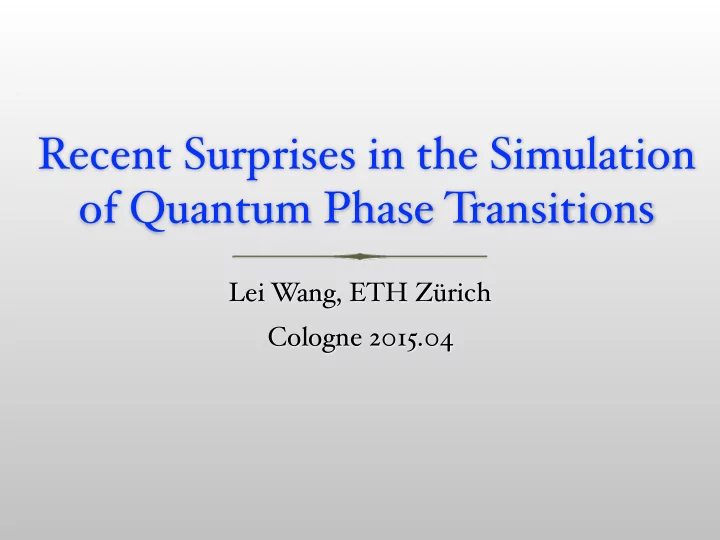

Recent Surprises in the Simulation of Quantum Phase T ransitions Lei W ang, ETH Zürich Cologne 2015.04
Quantum Phase T ransitions H ( λ ) = ˆ ˆ H 0 + λ ˆ H 1 Quantum Temperature Where is the QCP ? Critical What are the phases ? Ordered Disordered What is the universality class ? What are the experimental signatures ? λ c
Quantum Phase T ransitions H ( λ ) = ˆ ˆ H 0 + λ ˆ H 1 Quantum Temperature Where is the QCP ? Critical What are the phases ? Ordered Disordered What is the universality class ? What are the experimental signatures ? λ c Algorithms for quantum many body systems exact quantum tensor network dynamical mean diagonalization Monte Carlo states field theories
Quantum Phase T ransitions H ( λ ) = ˆ ˆ H 0 + λ ˆ H 1 Quantum Temperature Where is the QCP ? Critical What are the phases ? Ordered Disordered What is the universality class ? What are the experimental signatures ? λ c Algorithms for quantum many body systems exact quantum tensor network dynamical mean diagonalization Monte Carlo states field theories
Monte Carlo Method ` h N hits i = 2 ⇡ d Bu ff on 1777 Statistical Mechanics: Algorithms and Computations W erner Krauth d { { ` The first recorded Monte Carlo simulation
1087 THE 0 R Y 0 F T SIN R A D I 0 L Y SIS 0 F W ATE R T RAe KEF FEe paths (a) and (b) can be designated H 2 0* and those instead, only water molecules with different amounts of following path (c) can be designated H 2 0t. It seems excitation energy. These may follow any of three paths: reasonable to assume for the purpose of these calcula- (a) The excitation energy is lost without dissociation tions that the ionized H 2 0 molecules will become the into radicals (by collision, or possibly radiation, as in H 2 0t molecules, but this is not likely to be a complete aromatic hydrocarbons). correspondence. (b) The molecules dissociate, but the resulting radi- In conclusion we would like to emphasize that the cals recombine without escaping from the liquid cage. qualitative result of this section is not critically de- (c) The molecules dissociate and escape from the pendent on the exact values of the physical parameters cage. In this case we would not expect them to move used. However, this treatment is classical, and a correct more than a few molecular diameters through the dense treatment must be wave mechanical; therefore the medium before being thermalized. result of this section cannot be taken as an a priori theoretical prediction. The success of the radical diffu- In accordance with the notation introduced by sion model given above lends some plausibility to the Burton, Magee, and Samuel,22 the molecules following occurrence of electron capture as described by this 22 Burton, Magee, and Samuel, J. Chern. Phys. 20, 760 (1952). crude calculation. Further work is clearly needed. THE JOURNAL OF CHEMICAL PHYSICS VOLUME 21, NUMBER 6 JUNE, 1953 Equation of State Calculations by Fast Computing Machines NICHOLAS METROPOLIS, ARIANNA W. ROSENBLUTH, MARSHALL N. ROSENBLUTH, AND AUGUSTA H. TELLER, Los Alamos Scientific Laboratory, Los Alamos, New Mexico AND EDWARD TELLER, * Department of Physics, University of Chicago, Chicago, Illinois (Received March 6, 1953) A general method, suitable for fast computing machines, for investigatiflg such properties as equations of state for substances consisting of interacting individual molecules is described. The method consists of a modified Monte Carlo integration over configuration space. Results for the two-dimensional rigid-sphere system have been obtained on the Los Alamos MANIAC and are presented here. These results are compared to the free volume equation of state and to a four-term virial coefficient expansion. I. INTRODUCTION II. THE GENERAL METHOD FOR AN ARBITRARY POTENTIAL BETWEEN THE PARTICLES T HE purpose of this paper is to describe a general In order to reduce the problem to a feasible size for method, suitable for fast electronic computing numerical work, we can, of course, consider only a finite machines, of calculating the properties of any substance number of particles. This number N may be as high as which may be considered as composed of interacting several hundred. Our system consists of a squaret con- individual molecules. Classical statistics is assumed, taining N particles. In order to minimize the surface only two-body forces are considered, and the potential effects we suppose the complete substance to be periodic, field of a molecule is assumed spherically symmetric. consisting of many such squares, each square contain- These are the usual assumptions made in theories of ing N particles in the same configuration. Thus we liquids. Subject to the above assumptions, the method define dAB, the minimum distance between particles A is not restricted to any range of temperature or density. and B, as the shortest distance between A and any of This paper will also present results of a preliminary two- the particles B, of which there is one in each of the dimensional calculation for the rigid-sphere system. squares which comprise the complete substance. If we Work on the two-dimensional case with a Lennard- have a potential which falls off rapidly with distance, Jones potential is in progress and will be reported in a there will be at most one of the distances AB which later paper. Also, the problem in three dimensions is can make a substantial contribution; hence we need consider only the minimum distance dAB. being investigated. t We will use * two-dimensional nomenclature here since it Now at the Radiation Laboratory of the University of Cali- is easier to visualize. The extension to three dimensions is obvious. fornia, Livermore, California.
Recommend
More recommend